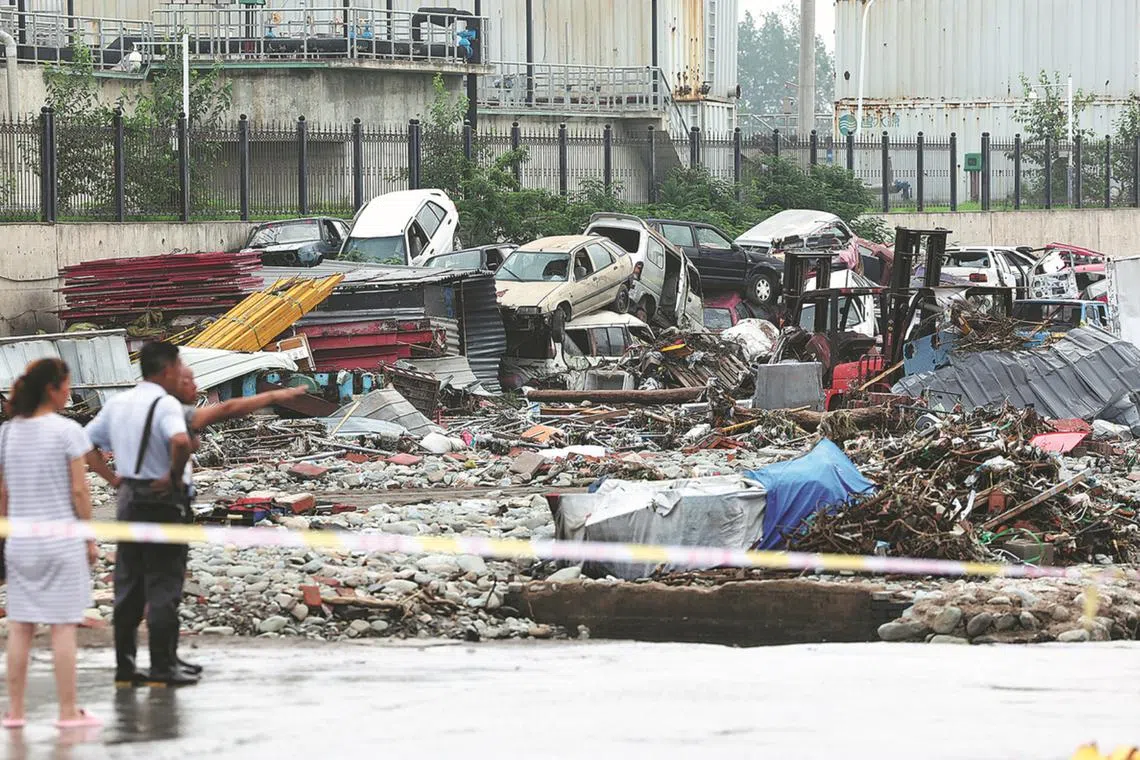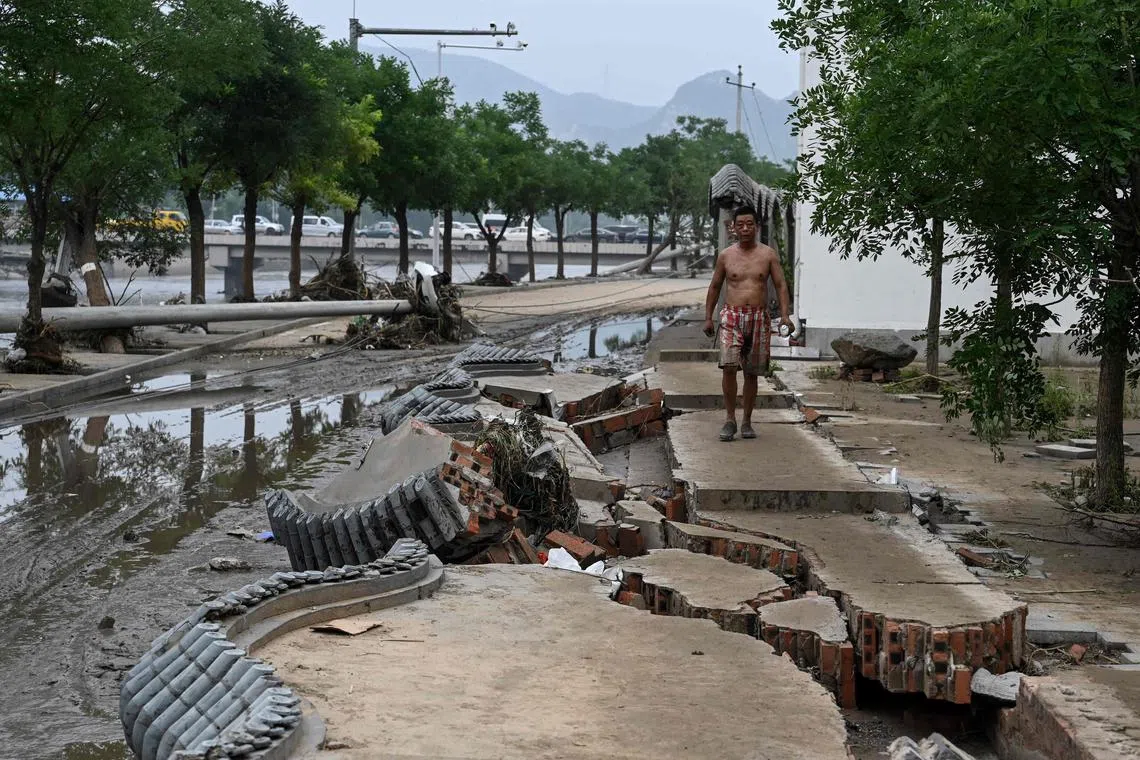Devastating floods in China shine spotlight on protection measures
Sign up now: Get ST's newsletters delivered to your inbox

The recent heavy rainfall in the Beijing-Tianjin-Hebei region was labelled a “historically extreme event” by China's National Meteorological Centre.
PHOTO: CHINA DAILY/ ASIA NEWS NETWORK
Follow topic:
BEIJING – Torrential rainfall and subsequent flooding in the Beijing-Tianjin-Hebei region have focused renewed attention on China’s determination to strengthen protection against natural disasters.
By implementing a “sponge city” concept
The “sponge city” initiative, launched to adapt to climate change, aims to reduce urban flooding by constructing facilities that help absorb and capture rainwater for future use.
Heavy rain brought by Typhoon Doksuri began to engulf the region on July 29.
Nearly 60 per cent of the 270 flood-affected villages in Beijing’s districts, including Fangshan, Mentougou, and Changping, have restored power supply, State Grid Beijing Electric Power Company told Xinhua news agency on Sunday.
Mr Zhu Dingzhen, former chief officer at the China Meteorological Administration’s Public Meteorological Service Centre, said: “Many regions in China still rely on infrastructure that adheres to outdated disaster defence standards.”
“If the climate keeps changing at the current rate, losses from such disasters will be considerably higher than in previous decades, due to current population numbers and the scale of economic development,” Mr Zhu said.
“It is crucial for China to plan and upgrade its infrastructure to adapt to future changes, as the nation faces a wide range of natural disasters due to its diverse climate and geographical features.”
For example, north-western regions could face the prospect of roads being washed away and river channels collapsing from as little as 20mm of rainfall.
The increased rainfall could saturate soil on the Loess Plateau, where many villages are situated on loess soil, and there is a heightened risk of secondary disasters, Mr Zhu said.
The recent heavy rainfall in the Beijing-Tianjin-Hebei region was labelled a “historically extreme event” by the National Meteorological Center.
The downpours surpassed others of a serious nature that occurred in the region in 1996, 2012 and 2016, with the centre saying that it rained continuously for 83 hours in Beijing from July 29 to last Tuesday.

A resident walking on a broken wall in the aftermath of flooding at a village following heavy rain in Beijing on Aug 3.
PHOTO: AFP
During this period, the accumulated rainfall was double or even triple the average for the time of year.
Beijing’s weather service said rainfall of 744.8 mm was recorded at Wangjiayuan Reservoir in the capital’s Changping district during this period, the largest amount recorded in the city for 140 years.
From 8am on July 29 to 5pm last Tuesday, the volume of rainfall in Beijing reached about 4.3 billion cubic m, Beijing News reported.
Professor of management and economics Zhang Chi of the Beijing Institute of Technology said adaptation measures are urgently needed.
The 2022 China report of the Lancet Countdown on Health and Climate Change said that from 2016 to 2020, the average exposure to extreme rainfall and drought per person increased by 71.6 per cent.
Prof Zhang, one of the report’s first authors, said: “Vulnerable groups are suffering more from climate change. For example, older people are at greater risk than young people from such extreme weather, but they are less willing to move home.”
She added: “The recent flooding not only devastated farmers’ crops but also harmed their health. Without immediate support and adaptation strategies to mitigate the impact, this already vulnerable group faces a vicious circle of adversity.”
The devastating impact of recent torrential rain has again highlighted the importance of China’s ongoing efforts to strengthen its defences against natural disasters.
The nation aims to build “sponge cities” to mitigate the impact of torrential rain. Such cities absorb, store, filter and purify rainwater. When needed, they release and use the stored water.
In 2014, the Ministry of Housing and Urban-Rural Development issued the pilot technical guidelines for sponge city construction, designating Beijing among the pilot cities for this concept.
The guidelines aim to create cities with the ability to adapt to environmental changes and effectively respond to natural disasters, functioning in a way similar to sponges.
Government departments, including urban planning, drainage, transport and landscaping, are involved in guiding the process.
The guideline states that to build such cities, efforts should be made to prevent urban areas from sprawling rapidly, and adequate areas of green space, along with footpaths made from permeable materials, should be provided.
Other efforts should include connecting water systems such as rivers, lakes, wetlands, ponds and canals with urban rainwater pipe networks and excess rainwater discharge systems, the guideline states.
The ministry said that over the years, problems have arisen, with some cities misunderstanding “sponge city” construction. These problems could hamper efforts to bolster resilience against disasters, according to a statement released by the ministry in 2022.
There are problems in building water filtration systems regardless of geological conditions, drawing drainage zoning boundaries based solely on administrative divisions, and adding drainage hurriedly after the completion of design plans for buildings, roads and gardens.
Mr She Nian, head of the Smart Sponge City Planning and Construction Research Institute at the Tsinghua Innovation Center in Zhuhai, Guangdong province, told Chinese newspaper Southern Weekly that the carrying capacity of northern “sponge cities” is lower than that of southern cities.
“Northern cities need to improve awareness of how ‘sponge cities’ tackle urban flooding, as in the past, northern regions have not experienced frequent rainfall or heavy storms like southern areas,” Mr She said.
During construction of sponge cities, attention should be paid to building green belts rather than relying solely on traditional rainwater drainage systems, he said.
In 2021, the United Nations Office for Project Services, the UN Environment Programme and the University of Oxford co-published a report titled Infrastructure for Climate Action.
The report emphasises the importance of treating infrastructure as a key area for addressing climate change, urging governments to reassess how to deliver and manage infrastructure to ensure it is suitable for a resilient future. CHINA DAILY/ASIA NEWS NETWORK

